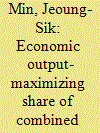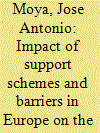|
|
|
Sort Order |
|
|
|
Items / Page
|
|
|
|
|
|
|
| Srl | Item |
| 1 |
ID:
099298


|
|
|
|
|
| Publication |
2010.
|
| Summary/Abstract |
As global fuel reserves are depleted, alternative and more efficient forms of energy generation and delivery will be required. Combined heat and power with district heating (CHP-DH) provides an alternative energy production and delivery mechanism that is less resource intensive, more efficient and provides greater energy security than many popular alternatives. It will be shown that the economic viability of CHP-DH networks depends on several principles, namely (1) the optimisation of engineering and design principles; (2) organisational and regulatory frameworks; (3) financial and economic factors. It was found that in the long term DH is competitive with other energy supply and distribution technologies such as electricity and gas. However, in the short to medium term it is shown that economic risk, regulatory uncertainty and lock-in of existing technology are the most significant barriers to CHP-DH development. This research suggests that under the present regulatory and economic paradigm, the infrastructure required for DH networks remains financially prohibitive; the implementation of government policies are complicated and impose high transaction costs, while engineering solutions are frequently not implemented or economically optimised. If CHP-DH is going to play any part in meeting climate change targets then collaboration between public and private organisations will be required. It is clear from this analysis that strong local government involvement is therefore necessary for the co-ordination, leadership and infrastructural deployment of CHP-DH.
|
|
|
|
|
|
|
|
|
|
|
|
|
|
|
|
| 2 |
ID:
101513


|
|
|
|
|
| Publication |
2010.
|
| Summary/Abstract |
The EU Directive 2004/8/EC, concerning the promotion of cogeneration, established principles on how EU member states can support combined heat and power generation (CHP). Up to now, the implementation of these principles into national law has not been uniform, and has led to the adoption of different promotion schemes for CHP across the EU member states. In this paper, we first give an overview of the promotion schemes for CHP in various European countries. In a next step, we take two standard CHP technologies, combined-cycle gas turbines (CCGT-CHP) and engine-CHP, and apply exemplarily four selected support mechanisms used in the four largest European energy markets: feed-in tariffs in Germany; energy efficiency certificates in Italy; benefits through tax reduction in the UK; and purchase obligations for power from CHP generation in France. For contracting companies, it could be of interest to diversify their investment in new CHP facilities regionally over several countries in order to reduce country and regulatory risk. By applying the Mean-Variance Portfolio (MVP) theory, we derive characteristic return-risk profiles of the selected CHP technologies in different countries. The results show that the returns on CHP investments differ significantly depending on the country, the support scheme, and the selected technology studied. While a regional diversification of investments in CCGT-CHP does not contribute to reducing portfolio risks, a diversification of investments in engine-CHP can decrease the risk exposure.
|
|
|
|
|
|
|
|
|
|
|
|
|
|
|
|
| 3 |
ID:
109437


|
|
|
|
|
| Publication |
2011.
|
| Summary/Abstract |
The first aim of this paper is to shed light on the thermodynamic reasons for the practical pursuit of low temperature operation by engineers involved in the design and the operation of combined heat and power (CHP) and district heating (DH) systems. The paper shows that the steam cycle of a combined heat and power generator is thermodynamically equivalent to a conventional steam cycle generator plus an additional virtual steam cycle heat pump. This apparently novel conceptualisation leads directly to (i) the observed sensitivity of coefficient of performance of CHP to supply and return temperatures in associated DH systems, and (ii) the conclusion that the performance of CHP will tend to be significantly higher than real heat pumps operating at similar temperatures. The second aim, which is pursued more qualitatively, is to show that the thermodynamic performance advantages of CHP are consistent with the goal of deep, long-term decarbonisation of industrialised economies. As an example, estimates are presented, which suggest that CHP based on combined-cycle gas turbines with carbon capture and storage has the potential to reduce the carbon intensity of delivered heat by a factor of ~30, compared with a base case of natural gas-fired condensing boilers.
|
|
|
|
|
|
|
|
|
|
|
|
|
|
|
|
| 4 |
ID:
150069


|
|
|
|
|
| Summary/Abstract |
We investigate lower than expected capacity factors of Combined Heat and Power plants using a publicly available dataset of hourly performance for plants in the state of New York. Low utilization of a CHP indicates underperformance. We examine possible causes of this underperformance including economic arbitrage, poor maintenance and operational practices, oversizing of plants, and reliability and resiliency needs. Based on seasonal and weekday/weekend capacity factor averages, we find that there is not enough evidence to support the economic arbitrage cause. Out of 99 plants in the dataset, 64 plants have average capacity factor below 60%, indicating they are either oversized and/or poorly maintained. This suggests that the current practice of one-time fixed incentive ($/kW) favors investment in capacity with no incentive for utilization (unlike a production credit which incentivizes generation $/kW h). From a policy perspective, this paper recommends better pre-engineering assessment for correct sizing, as well as revision of incentives based on performance. Additional information should be collected so that a more accurate ongoing analysis of the societal benefits of CHP projects can be made. Lastly, the energy efficiency gap may be smaller than is commonly assumed and other options should be explored to meet energy efficiency goals.
|
|
|
|
|
|
|
|
|
|
|
|
|
|
|
|
| 5 |
ID:
167018


|
|
|
|
|
| Summary/Abstract |
The combined heat and power (CHP) generation, which can produce both heat and electricity at the same time, is so efficient that it can reduce energy use and even mitigate CO2 and air pollutants emissions. For this reason, the share of CHP generation worldwide is increasing and the optimal share of CHP generation in electric power generation is a serious concern in South Korea. This article attempts to estimate the optimal share by modeling the plausible relationship between CHP generation and national output in the Cobb-Douglas production function setting and then deriving the output-maximizing share of CHP generation. The production function is estimated for annual data from 1995 to 2017 using several quantile regressions. The optimal share is computed to be 13.8%. Therefore, it is recommended that South Korea should increase the share of CHP generation slightly, given that the share was 8.6% in 2017. If the optimal CHP share instead of the actual CHP share had been achieved in 2017, GDP in 2017 could have increased by 0.82%.
|
|
|
|
|
|
|
|
|
|
|
|
|
|
|
|
| 6 |
ID:
112267


|
|
|
|
|
| Publication |
2012.
|
| Summary/Abstract |
Small nuclear reactors align well with the small heat-capacity needs for many European process industries. Combined heat and power (CHP) reactors can support the EU low-carbon society goals while providing stability in production and cost. High temperature reactor technologies are well suited for the production of "high value" heat by producing temperatures of 200-550 °C. However, little is known about the market potential or economic competitiveness of these reactors in future European cogeneration markets. This study shows that the greatest potential is in chemical/petroleum, paper, metal, and bioenergy markets with small capacities (50-250 MWth). Target market costs for coal-CHP and natural gas-CHP were determined to range from 60-100 €/MWh and 95-208 €/MWh, respectively. Costs for "heat-only" ranges from 30-60 €/MWh based on gas boilers. Parametric analysis was used to create a cost breakdown (capital, operations and maintenance, fuel, and decommissioning) for an equivalent nuclear CHP that could compete against coal-CHP and natural gas-CHP. Sensitivity analysis showed that reactor capital costs and the costs of capital had the largest influence on competitiveness. In summary, the opportunities for nuclear CHP are highest in natural gas-CHP markets; however the benefits for CO2 reduction were greatest against coal-CHP.
|
|
|
|
|
|
|
|
|
|
|
|
|
|
|
|
| 7 |
ID:
090050


|
|
|
|
|
| Publication |
2009.
|
| Summary/Abstract |
The purpose of this paper is to investigate the feasibility of installing gasification-based energy plants in the New Zealand wood processing industry. The study compared energy plants supplying the thermal and electrical energy in sawmills, laminated veneer lumber (LVL) plants and medium density fibreboard (MDF) mills. The breakeven electricity price for the MDF and LVL scenarios ranged from 4-8.9 c/kWh while the sawmill scenario was 11.6 c/kWh. The conclusion of the study is that while the economics are comparable with other renewable energy generation methods such as hydro and wind the location of the plant is critical to overall feasibility due mainly to biomass availability and power price both now and in light of expected future trends. The technology is complementary to the government's forward strategy which encourages both distributed generation and renewable energy.
|
|
|
|
|
|
|
|
|
|
|
|
|
|
|
|
| 8 |
ID:
098259


|
|
|
|
|
| Publication |
2010.
|
| Summary/Abstract |
Energy-saving technologies' applicability to making cities more environmentally sustainable can be strongly influenced by the city's form, building uses and their density pattern. Technological developments have clearly shown specific urban forms to be more conducive to installing certain mitigation technologies. In this study, the capacity for implementation and impacts on energy savings and subsequent greenhouse gas (GHG) reduction potential of mitigation technologies such as photovoltaic cells (PV) and combined heat and power (CHP) technologies were analysed with respect to three potential urban forms (high density centralised, medium density averaged and low density de-centralized) for Utsunomiya City, Japan. Given current building use patterns, scenarios for 2030 and 2050, showed the medium density averaged form, which benefits from both PV and CHP technologies, to outperform the other forms, resulting in an energy savings and GHG reduction potential of 27.6% in 2030 and 67.6% in 2050. Interestingly, GHG reduction in 2050 was primarily attributable to PV, while CHP technology had the greater influence in 2030. Despite the limitation of the analysis, the study provides a useful insight, highlighting the relationship between urban forms and GHG reduction potential by two energy-saving technologies.
|
|
|
|
|
|
|
|
|
|
|
|
|
|
|
|
| 9 |
ID:
098554


|
|
|
|
|
| Publication |
2010.
|
| Summary/Abstract |
Energy-saving technologies' applicability to making cities more environmentally sustainable can be strongly influenced by the city's form, building uses and their density pattern. Technological developments have clearly shown specific urban forms to be more conducive to installing certain mitigation technologies. In this study, the capacity for implementation and impacts on energy savings and subsequent greenhouse gas (GHG) reduction potential of mitigation technologies such as photovoltaic cells (PV) and combined heat and power (CHP) technologies were analysed with respect to three potential urban forms (high density centralised, medium density averaged and low density de-centralized) for Utsunomiya City, Japan. Given current building use patterns, scenarios for 2030 and 2050, showed the medium density averaged form, which benefits from both PV and CHP technologies, to outperform the other forms, resulting in an energy savings and GHG reduction potential of 27.6% in 2030 and 67.6% in 2050. Interestingly, GHG reduction in 2050 was primarily attributable to PV, while CHP technology had the greater influence in 2030. Despite the limitation of the analysis, the study provides a useful insight, highlighting the relationship between urban forms and GHG reduction potential by two energy-saving technologies.
|
|
|
|
|
|
|
|
|
|
|
|
|
|
|
|
| 10 |
ID:
124301


|
|
|
|
|
| Publication |
2013.
|
| Summary/Abstract |
This paper analyses the effectiveness of different support measures to promote cogeneration in the European Union. The analysis looks into the average progress of cogeneration between two different periods. The economic effect of the support measures in each country is quantified with the help of a cost-benefit analysis carried out by the Cogeneration Observatory and Dissemination Europe (CODE) project. The scope of this study is necessarily affected by the need to limit the number of projects and support measures. However, there is no evidence of a relationship between the economic advantage offered by support measures and the deployment of cogeneration in the Member States. The study considers the effect of different barriers (reported by the Member States) on the promotion of cogeneration. The individual analyses of the barriers differ widely in quality and depth. When some barriers are reported, there is an increase of the variability of the penetration of cogeneration. This counter-intuitive fact leads us to conclude that there is a lack of consistency in the barriers reported, and a clear need for consistent reporting on barriers. The possible effect of competition between measures supporting combined heat and power and renewable energy sources is also analysed.
|
|
|
|
|
|
|
|
|
|
|
|
|
|
|
|
| 11 |
ID:
115143


|
|
|
|
|
| Publication |
2012.
|
| Summary/Abstract |
This paper argues that Sweden's old and established district heating sector is heading into a stagnation phase. The aim is to analyse the factors influencing this development as well as the strategies used by involved parties to prevent stagnation. Using large technical system theory, I analyse internal and external factors potentially causing stagnation. The most obvious external factors are: an increase in the number of energy-efficient buildings, in response to stricter energy policies, which reduces the future potential for district heating in new and existing buildings; climate change; competition from other heating systems; and market saturation in the key sector, multi-dwelling buildings. The main internal factor is changed business strategies following electricity market deregulation, when energy companies were supposed to be run on businesslike terms. I also argue that stagnation can be defined as occurring when the key measure feature of a system, in this case, heat load is starting to stagnate or decline, even though the trend is positive in other areas. The strategies for avoiding stagnation are various forms of broadening scope, primarily by focusing more on electricity production by building combined heat and power plants, or using the alternative value of the technical system for new applications.
|
|
|
|
|
|
|
|
|
|
|
|
|
|
|
|
| 12 |
ID:
110735


|
|
|
|
|
| Publication |
2011.
|
| Summary/Abstract |
Combined heat and power (CHP) plants dominate the heating market in China. With the ongoing energy structure reformation and increasing environmental concerns, we propose gas-fired boilers to be deployed in underperforming heating substations of heating networks for peak load compensation, in order to improve both energy efficiency and environmental sustainability. However, due to the relatively high price of gas, techno-economic analysis is required for evaluating different combined heating scenarios, characterized by basic heat load ratio (ß). Therefore, we employ the dynamic economics and annual cost method to develop a techno-economic model for computing the net heating cost of the system, considering the current state of the art of cogeneration systems in China. The net heating cost is defined as the investment costs and operations costs of the system subtracted by revenues from power generation. We demonstrate the model in a real-life combined heating system of Daqing, China. The results show that the minimum net heating cost can be realized at ß=0.75 with a cost reduction of 16.8% compared to coal heating alone. Since fuel cost is the dominating factor, sensitivity analyses on coal and gas prices are discussed subsequently.
|
|
|
|
|
|
|
|
|
|
|
|
|
|
|
|
| 13 |
ID:
176781


|
|
|
|
|
| Summary/Abstract |
Combined Heat and Power (CHP) has again become a key element in international energy and environmental policy, since it is one of the most promising methods of ensuring grid stability, making an energy system more flexible and environmentally friendly. This is particularly true in the case of Chile, which has an energy system that progressively introduced volatile renewable energy sources such as wind and solar energy. This scenario has led to the development of a new regulatory strategy and CHP flagship projects throughout the country. Despite this interest, there has been no analysis of CHP development or the impact of the latest regulatory changes on its evolution. This study presents an updated cadastre of the CHP facilities as of 2018, together with an analysis of its evolution in terms of an energy policy. From this cadastre, interviews with experts, and a review of the regulations and incentives, the study identifies the main policy barriers for CHP development in Chile. Furthermore, this study presents a series of challenges and recommendations for the country.
|
|
|
|
|
|
|
|
|
|
|
|
|
|
|
|
|
|
|
|
|